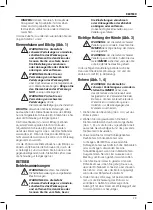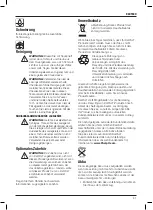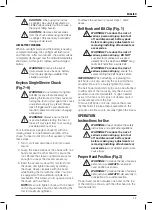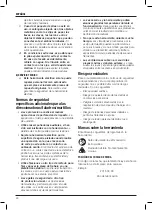
37
english
• Before using charger, read all instructions and
cautionary markings on charger, battery pack,
and product using battery pack.
WARNING:
Shock hazard. Do not allow
any liquid to get inside charger. Electric
shock may result.
WARNING:
We recommend the use of
a residual current device with a residual
current rating of 30mA or less.
CAUTION:
Burn hazard. To reduce
the risk of injury, charge only
D
e
WALT
rechargeable batteries. Other types of
batteries may burst causing personal
injury and damage.
CAUTION:
Children should be
supervised to ensure that they do not
play with the appliance.
NOTICE:
Under certain conditions,
with the charger plugged into the power
supply, the exposed charging contacts
inside the charger can be shorted by
foreign material. Foreign materials of
a conductive nature such as, but not
limited to, steel wool, aluminum foil or
any buildup of metallic particles should
be kept away from charger cavities.
Always unplug the charger from the
power supply when there is no battery
pack in the cavity. Unplug charger before
attempting to clean
• DO NOT attempt to charge the battery pack
with any chargers other than the ones in
this manual.
The charger and battery pack are
specifically designed to work together.
• These chargers are not intended for
any uses other than charging
D
e
WALT
rechargeable batteries.
Any other uses
may result in risk of fire, electric shock or
electrocution.
• Do not expose charger to rain or snow.
• Pull by plug rather than cord when
disconnecting charger.
This will reduce risk
of damage to electric plug and cord.
• Make sure that cord is located so that it
will not be stepped on, tripped over, or
otherwise subjected to damage or stress
.
• Do not use an extension cord unless it
is absolutely necessary.
Use of improper
extension cord could result in risk of fire,
electric shock, or electrocution.
• Do not place any object on top of charger
or place the charger on a soft surface that
might block the ventilation slots and result
in excessive internal heat.
Place the charger
• Wear safety goggles or other eye protection.
Hammering and drilling operations cause chips
to fly. Flying particles can cause permanent eye
damage.
• Accessories and tool may get hot during
operation.
Wear gloves when handling them if
performing heat producing applications such as
hammerdrilling and drilling metals.
• Do not operate this tool for long periods of
time.
Vibration caused by hammer action may
be harmful to your hands and arms. Use gloves
to provide extra cushion and limit exposure by
taking frequent rest periods.
• Air vents often cover moving parts and
should be avoided.
Loose clothes, jewelry or
long hair can be caught in moving parts.
Residual Risks
In spite of the application of the relevant safety
regulations and the implementation of safety
devices, certain residual risks cannot be avoided.
These are:
– Impairment of hearing.
– Risk of squeezing fingers when changing
accessories.
– Health hazards caused by breathing dust
developed when working in wood.
– Risk of personal injury due to flying particles.
– Risk of personal injury due to prolonged use.
Markings on Tool
The following pictograms are shown on the tool:
Read instruction manual before use.
Visible radiation. Do not stare into light.
DATE CODE POSITION
The date code, which also includes
the year of
manufacture, is printed into the housing.
Example:
2015 XX XX
Year of Manufacture
Important Safety Instructions for All
Battery Chargers
SAVE THESE INSTRUCTIONS:
This manual
contains important safety and operating
instructions for compatible battery chargers (refer to
Technical Data
).
















































